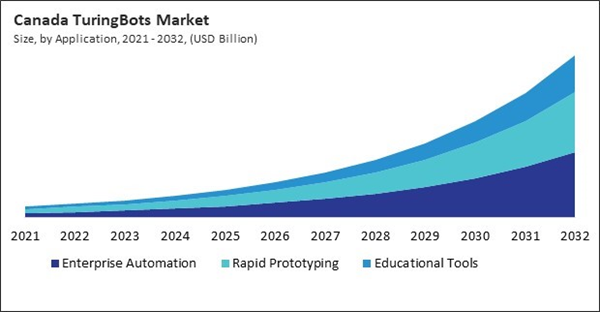The US market dominated the North America TuringBots Market by country in 2024, and is expected to continue to be a dominant market till 2032; thereby, achieving a market value of $6.25 billion by 2032. The Canada market is experiencing a CAGR of 28.6% during 2025-2032. Additionally, the Mexico market is expected to exhibit a CAGR of 27.9% during 2025-2032.
This market has emerged as a transformative force in software development, driven by advancements in artificial intelligence (AI) and the growing demand for efficient, automated solutions. TuringBots, AI-powered software agents, assist in various stages of the software development lifecycle, including planning, designing, coding, testing, and deployment. Their integration into development processes addresses challenges such as the shortage of skilled developers and the need for rapid digital transformation.
Initially, TuringBots operated under human supervision, providing assistance in specific tasks. As AI technologies matured, these bots evolved to become collaborative partners, capable of interacting with human developers and contributing more significantly to projects. The current trajectory points towards TuringBots achieving greater autonomy, handling complex workflows with minimal human intervention, while still under strategic oversight.
The North American market has emerged as a pivotal force in the evolution of software development, driven by the region's robust technological infrastructure and a culture of innovation. The term "TuringBots," coined by Forrester, refers to AI-powered software agents that assist in various stages of the software development lifecycle (SDLC), including planning, coding, testing, and deployment. In North America, the adoption of TuringBots has been accelerated by the region's emphasis on digital transformation and the need for rapid, efficient software delivery.
The evolution of TuringBots in North America can be traced back to the early 2020s, with the integration of AI tools like GitHub Copilot and AWS CodeWhisperer into development workflows. These tools have significantly enhanced developer productivity by automating routine coding tasks and providing intelligent code suggestions. Forrester predicts that by 2028, TuringBots could reduce software development timelines by up to 50%, highlighting their transformative potential. This projection underscores the growing reliance on AI to meet the demands of modern software development. The North American market is rapidly evolving, marked by notable trends that are reshaping software development practices across industries.
As AI-powered coding assistants mature in functionality and scale, organizations are integrating these tools more deeply into their development workflows. One prominent trend is the widespread integration of TuringBots throughout the software development lifecycle (SDLC). In North America, where digital transformation initiatives are a strategic priority across both public and private sectors, developers are increasingly adopting TuringBots to automate code generation, testing, debugging, and documentation. In conclusion, the North American TuringBots market is highly competitive, with incumbents competing on ecosystem integration, AI model performance, security, and transparency.
List of Key Companies Profiled
- Microsoft Corporation
- Amazon Web Services, Inc. (Amazon.com, Inc.)
- IBM Corporation
- Google LLC (Alphabet Inc.)
- UiPath, Inc.
- Tabnine Ltd.
- SAP SE
- Baidu, Inc.
- JetBrains N.V.
- Cognizant Technology Solutions Corporation
Market Report Segmentation
By Technology
- Generative AI
- Natural Language Processing (NLP)
- Machine Learning
By Application
- Enterprise Automation
- Rapid Prototyping
- Educational Tools
By User
- Large Enterprises
- Small & Medium Enterprises
- Individual Users
By Function
- Design
- Code Generation
- Automated Testing
- Debugging/Optimization
- Deployment/DevOps
- Analytics & Maintenance
By Country
- US
- Canada
- Mexico
- Rest of North America
Table of Contents
Companies Mentioned
- Microsoft Corporation
- Amazon Web Services, Inc. (Amazon.com, Inc.)
- IBM Corporation
- Google LLC (Alphabet Inc.)
- UiPath, Inc.
- Tabnine Ltd.
- SAP SE
- Baidu, Inc.
- JetBrains N.V.
- Cognizant Technology Solutions Corporation









